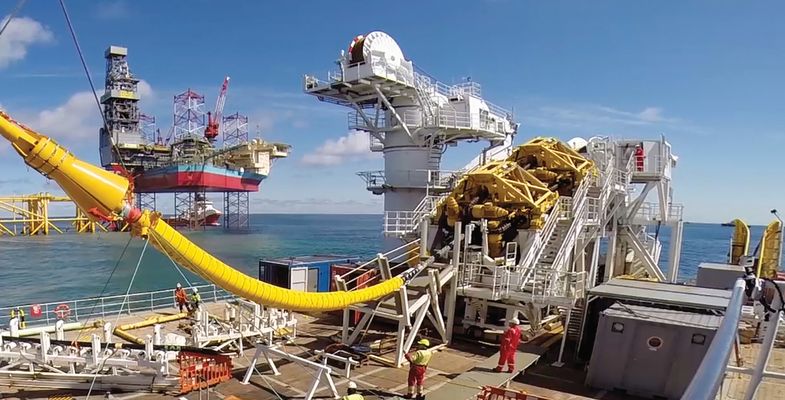IEC 62895 HVDC Submarine Cable Testing
The IEC 62895 standard is a critical document for the testing and certification of high-voltage direct current (HVDC) submarine cables. These cables are essential components in modern energy infrastructure, particularly for long-distance electricity transmission across bodies of water. The standard addresses the unique challenges associated with HVDC submarine cable systems, including environmental factors, mechanical stresses, and electrical performance.
IEC 62895 specifies detailed test procedures aimed at ensuring that HVDC submarine cables meet stringent safety and reliability standards. This includes insulation testing, fault location methods, and life cycle assessment. The standard is particularly important for offshore platforms and subsea installations where the integrity of cable systems can have significant implications on operational efficiency and environmental impact.
The testing process outlined in IEC 62895 involves a series of rigorous evaluations that simulate real-world conditions experienced by submarine cables. This includes hydrostatic pressure testing to ensure the cable’s insulation remains intact under water, mechanical stress tests to assess resilience against external forces such as anchor dragging or seabed movements, and electrical resistance measurements to verify the integrity of the conductor.
For quality managers and compliance officers, understanding these test parameters is crucial. They need to ensure that the cables they procure or manufacture adhere strictly to IEC 62895 standards. R&D engineers involved in the design and development of such systems must be familiar with the latest testing methodologies prescribed by this standard. This knowledge helps them anticipate potential issues during installation and operation, thereby enhancing overall safety and performance.
IEC 62895 also emphasizes the importance of life cycle management for HVDC submarine cables. This involves not only initial manufacturing quality but also regular inspections and maintenance to extend the operational lifespan of these critical assets. By adhering to this standard, stakeholders can contribute significantly towards sustainable energy solutions that minimize environmental footprints.
Compliance with IEC 62895 is mandatory for any organization dealing with HVDC submarine cable systems in sectors like renewable energy and offshore platforms. It ensures interoperability across different projects and regions, fostering a collaborative global market where standards are universally recognized.
Benefits of IEC 62895 HVDC Submarine Cable Testing
The implementation of IEC 62895 testing protocols offers numerous advantages to various stakeholders within the energy sector. For manufacturers and suppliers, it provides a robust framework for quality assurance, ensuring that all products meet stringent international standards before reaching the market.
From an operational standpoint, adherence to this standard helps in reducing risks associated with cable failures, which could lead to costly disruptions or accidents. By conducting thorough tests as per IEC 62895 guidelines, operators can identify potential weaknesses early on and address them proactively.
A significant benefit lies in the enhanced reliability of HVDC submarine cable systems. This translates into more efficient power transmission capabilities, contributing positively towards achieving renewable energy targets set by countries worldwide. Moreover, compliance with IEC 62895 fosters trust among customers who seek reliable and sustainable infrastructure solutions.
The standard also plays a crucial role in promoting innovation within the industry. Developers are encouraged to explore new technologies that can withstand rigorous testing conditions outlined by this document. This encourages continuous improvement in product design, leading to advancements that benefit both consumers and producers alike.
Industry Applications of IEC 62895 HVDC Submarine Cable Testing
| Application Area | Description |
|---|---|
| Renewable Energy Projects | Testing for offshore wind farms and solar parks connected via submarine cables. |
| Offshore Oil & Gas Platforms | Evaluating safety and reliability of communication and power supply systems. |
| Hydroelectric Power Plants | Assuring efficient transmission lines between land-based facilities and remote locations. |
| Marine Infrastructure Development | Supporting the installation of new ports or maritime routes requiring robust submarine networks. |
| Environmental Impact Assessments | Evaluating potential impacts on aquatic ecosystems from underwater cable installations. |
The application areas listed above highlight how IEC 62895 plays a pivotal role in ensuring the integrity and safety of HVDC submarine cables across diverse sectors. Each sector faces unique challenges, but by following these testing protocols, organizations can mitigate risks effectively while promoting sustainable practices.
International Acceptance and Recognition of IEC 62895 HVDC Submarine Cable Testing
The International Electrotechnical Commission (IEC) is responsible for setting global standards that promote the safe, efficient, and environmentally friendly development of electrical technology. IEC 62895 specifically focuses on high-voltage direct current submarine cables used in marine environments.
Given its stringent requirements, this standard enjoys widespread acceptance across multiple countries and regions. Organizations involved in HVDC submarine cable projects around the world rely heavily upon it for compliance purposes. This ensures that regardless of geographical location, all stakeholders follow consistent practices when evaluating these crucial components.
Recognized by major international bodies like ISO (International Organization for Standardization) and IEEE (Institute of Electrical and Electronics Engineers), IEC 62895 adds credibility to any project adhering to its guidelines. It serves as a benchmark against which other standards can be compared, reinforcing its significance within the industry.
By embracing these internationally recognized standards, companies not only demonstrate their commitment to quality but also enhance their reputation among clients and partners globally. This is particularly true for firms operating in competitive markets where reliability and safety are paramount considerations.





